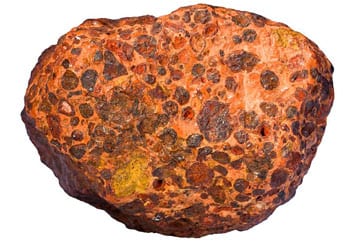Интихоб кунед ба забони тоҷикӣ:
Алюминий унсури филизӣ бештар пайдо дар рӯи замин аст,, totaling about 8% аз ќадре замин. Аммо, aluminum as an element is reactive and therefore does not occur naturally – it needs to be refined to produce aluminum metal. Маводи оғоз ибтидоӣ барои тоза кардани алюминий bauxite аст, асосии манбаъ тиҷоратӣ, ки ҷаҳон ба алюминий. Bauxite is a sedimentary rock, and consists mostly of the aluminium minerals gibbsite (Al(OH)3), boehmite (в-аъло(OH)) ва diaspore (як-аъло(OH)), and is usually mixed with the two iron oxides goethite and hematite, the aluminium clay mineral kaolinite and small amounts of anatase (TiO2) and/or ilmenite (FeTiO3).

пасандозҳо Bauxite мебошанд паҳншавии дар саросари ҷаҳон, асосан дар минтақаҳои тропикӣ ва ё субтропикӣ рух. Although proven reserves of bauxite are expected to last for many years, ба сифати захираи, ки метавонанд љињати иќтисодї дастрас аст, коҳиш. Барои refiners, who are in the business of bauxite processing to make alumina, ва метал оқибат алюминий, Ин мушкилоти бо ҳам оқибатҳои молиявӣ ва муҳити зист аст.
The process to refine metallurgical bauxite into alumina involves the following inputs:
The following outputs are generated:

The most widely used chemical process of refining bauxite into alumina, раванди Байер, involves dissolving the Al2O3 out of the bauxite rock with caustic soda (NaOH) at elevated temperature and pressure. The Al2O3 fraction of the bauxite is dissolved into solution, to later be precipitated out as alumina. Аммо, a high-grade bauxite contains up to 60% Al2O3, and many operating bauxite deposits are well below this, баъзан кам 30-40% Al2O3. Because the desired product is a high purity Al2O3, Дар оксиди боқимонда дар bauxite (Fe2O3, SiO2, TiO2, Organic material) are separated from the Al2O3 and rejected as alumina refinery resides (повстанцев) or red mud. Умуман, сифати камтар bauxite (ie lower Al2O3 content) the more red mud is generated per ton of alumina product. Дар Илова, even some Al2O3 bearing minerals, хусусан kaolinite, produce un-desirable side reactions during the refining process and lead to an increase in red mud generation, инчунин аз даст додани гарон кимиёвии содаи caustic, арзиши тағйирёбанда калон дар раванди тоза кардани bauxite.
лой сурх ё повстанцев намояндагӣ калон ва-рафта мушкилоти барои саноати алюминий. лой сурх дорои назаррас caustic боқимондаи leftover химиявї, аз раванди тоза кардани ба, ва хеле alkaline, аксаран бо мањлули 10 - 13. It is generated in large volumes worldwide – according to the USGS, тахминан истеҳсоли гилхок саросарӣ шуд 121 миллион тонна дар 2016. This likely resulted in more than 150 миллион тонна лой сурх тавлидшуда дар давоми ҳамин давраи. Сарфи назар аз таҳқиқоти ҷорӣ, лой сурх феълан чанд роҳҳои тиҷоратӣ воқеии фоиданок аз нав истифода. Ҳисоб шудааст, ки хеле кам лой сурх аст судманди нав истифода дар саросари ҷаҳон. Instead the red mud is pumped from the alumina refinery into storage impoundments or landfills, ки дар он аст, захира шудаанд ва аз хисоби калон назорат.
Аз даст содаи caustic гарон (NaOH) and the generation of red mud are both related to the quality of the bauxite used in the refining process. Умуман, the lower the Al2O3 content of the bauxite, Дар калонтар ҳаҷми лой сурх, ки ба тавлид мешавад, as the non-Al2O3 phases are rejected as red mud. Дар Илова, the higher the kaolinite or reactive silica content of the bauxite, лой сурх бештар тавлид хоҳад шуд. The reactive silica content not only increases the volume of red mud, but also consumes caustic soda reagent and reduces the yield of Al2O3 recovered from the bauxite. Бинобар ин, there is both an economic and environmental argument to be made for improving the quality of bauxite prior to refining.
Раванди тақсимоти хушк STET пешниҳодҳои bauxite истеьсолкунандагони ё refiners bauxite имконияти иҷрои такмили пеш Байер-раванди маъдан bauxite беҳтар намудани сифати. Чунин муносибат дорад, бисёр манфиат меорад:
Дар ҷамъбаст, коркарди хушк бо имкониятҳои STET ҷудосози пешниҳод ба тавлиди арзиш барои истеьсолкунандагони bauxite ва refiners. Ба пеш коркарди bauxite пеш аз тоза кардани хароҷоти кимиёвӣ кам, паст кардани ҳаҷми лой сурх тавлид ва кам кардани upsets раванди.
Адабиёт: